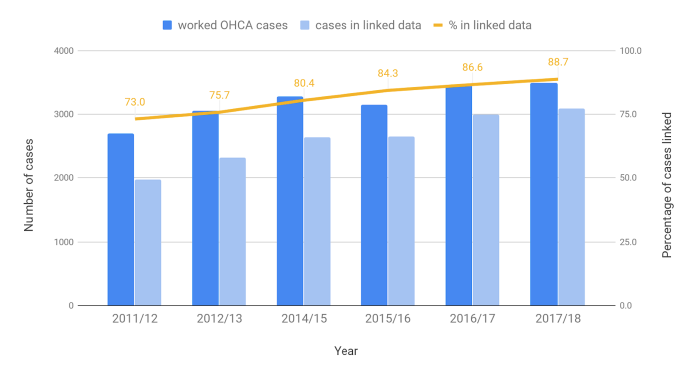Out-of-Hospital Cardiac Arrest data linkage project: 2017-2018 results
Third report on Scottish Out-of-Hospital Cardiac Arrest (OHCA) data linkage project tracks key patient outcomes as strategy partners attempt to optimise implementation of the 'Chain of Survival' across Scotland.
Out-of-Hospital Cardiac Arrest Data for 2017/18
Number of worked arrests
'Worked arrests' are those non-traumatic OHCA where resuscitation was attempted by the Scottish Ambulance Service (SAS). This number forms the denominator for all subsequent outcome calculations. There are a number of reasons why SAS may not attempt resuscitation including obvious death, or the confirmation that resuscitation was not the patient's wish - for example by the presence of a 'do not attempt CPR' order as part of an anticipatory care plan. Table 1 below shows the number of worked arrests has increased gradually from 2,692 patients in 2011/12 to 3,484 in 2017/18.
Table 1: Number of worked arrests and proportion linked
| Time Period | Number of OHCA cases resuscitated by the Scottish Ambulance Service | Number of cases in the linked dataset | Proportion of cases which were linked (%) |
|---|---|---|---|
| 2011/12 | 2,692 | 1,966 | 73.0 |
| 2012/13 | 3,047 | 2,306 | 75.7 |
| 2014/15 | 3,277 | 2,634 | 80.4 |
| 2015/16 | 3,142 | 2,648 | 84.3 |
| 2016/17 | 3,455 | 2,991 | 86.6 |
| 2017/18 | 3,484 | 3,090 | 88.7 |
Table 1 showing the number of OHCA cases resuscitated by the Scottish Ambulance Service each year between 2011/12 and 2017/18. Complete data for 2013/14 was not available and is omitted.
Data Linkage
The collection and preparation of data contained in this report follows the same methodology of our previous report: Initial Results of the Scottish Out-of-Hospital Cardiac Arrest Data Linkage Project [2].
In brief, the SAS provided data on all OHCA incidents where resuscitation was attempted during the reporting period. Where possible, the patients involved in each incident were linked to survival outcome data via their Community Health Index (CHI) number by the Information Services Division, NHS National Services Scotland. In addition, measures such as the Scottish Index of Multiple Deprivation (SIMD)[3] were applied to the dataset to allow further analysis.
The proportion of linked arrests has increased from 73.0% in 2011/12 to 88.7% in the 2017/18. Figure 1 below shows the gradual increase in the number of worked arrests each year. It also shows a gradual improvement in the number of these cases which have been linked to clinical outcomes via the CHI number.
Figure 1: Proportion of worked OHCA included in linked dataset

Figure 1 showing the number of worked OHCA cases which were linked to outcome data each year between 2011/12 and 2017/18. Complete data for 2013/14 was not available and is omitted.
Contact
Email: Guy McGivern
There is a problem
Thanks for your feedback